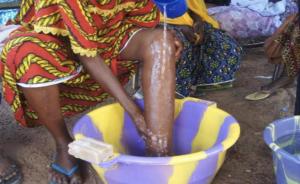Cameroon on the path to eliminating elephantiasis
Maroua – “At first, I felt itchy and scratched my body all the time, then my foot started to swell,” says Jacob, a 56-year-old farmer from Goudour in the far north region of Cameroon. “I was ashamed to go out in public. I covered my foot and everyone looked at me strangely. I couldn't even work normally anymore."
Jacob had contracted lymphatic filariasis, better known as elephantiasis, a few years ago. This debilitating parasitic disease is transmitted from one person to another by the bite of the anopheles mosquito, the same mosquito that transmits malaria.
According to a mapping study conducted in Cameroon between 2010 and 2012 with USAID support, 144 of the country’s 200 health districts are affected by lymphatic filariasis and all the 10 regions of the country are impacted.
In response, the country developed a plan to eliminate lymphatic filariasis by 2030. The plan is mainly built around community-based treatment and management of complicated cases.
Consequently, the Ministry of Public Health has conducted mass treatment campaigns for 10 years in the affected areas. Each year, World Health Organization (WHO) provides the country with more than 10 million Albendazole tablets, which have been administered to communities in the 144 endemic health districts.
The Organization has also supported the training of health workers in case management, as well as in the storage of medicines, record keeping, and supervision of distribution operations.
As for community health workers, they have been trained in mobilization and awareness-raising. Their job is to establish contact with communities and inform them about the disease, as well as the advantages of community-based treatment.
"At first, people thought it was a mystical disease caused by witchcraft, bad spells, and even poor hygiene." Swollen limbs were seen as symptoms of cancer," says Pascal Sawalda, a community health worker in Goudour.
Owing to poor knowledge about the disease and false beliefs, people often turn to traditional healers. "To convince people to abandon false beliefs, I use testimonies from former patients, stressing the complications that can arise from not treating the disease and highlighting the benefits of taking medicines in the community."
With the involvement of community health workers in awareness-raising, identifying complicated cases and referring people to health facilities, attitudes towards the disease are changing and the results are encouraging.
The mass drug administrations between 2012 and 2022 made significant progress towards the elimination of lymphatic filariasis in Cameroon. Initial assessments have shown that all the 144 health districts have now reached the end point for mass distribution of medicines. "To date, 143 health districts have successfully undergone the first monitoring assessment and 96 have already undergone the second monitoring assessment," says Dr Blandine Clarisse Ebene, Deputy Permanent Secretary of the National Onchocerciasis and Lymphatic Filariasis Control Programme at the Ministry of Public Health.
The programme has received technical and financial support from WHO to facilitate the conduct of mapping studies, the purchase of medicines, capacity-building for programme managers to roll out mass treatments and surveys on the impact of mass treatments. The support has helped to achieve the current results.
Despite the progress made, several challenges need to be overcome, including the management of morbidity related to lymphatic filariasis. To that end, the country can count on its partners, including WHO.
"We will support the country until certification of the elimination of lymphatic filariasis," says Dr Phanuel Habimana, WHO Representative in Cameroon.
Cameroon is engaged in a cross-cutting fight against lymphatic filariasis. The country is combining mass distribution campaigns with vector control efforts by providing the population with insecticide-treated mosquito nets.
"The fact that this disease has almost been eliminated in my community makes me proud and relieved because it is debilitating and carries a stigma," says Pascal, a community health worker.
In Goudour, Jacob is completely healed and has resumed his normal life. “I went to the hospital where I received some medicines. I followed the mass treatment for six years. Since then, I’ve stopped scratching my body and my foot has stopped swelling," he explains. “Today, I go about my business as usual and I’ve reconnected with my friends.”
Communications Officer
Regional Office for Africa
Email: lawsonagbluluf [at] who.int (lawsonagbluluf[at]who[dot]int)
Communications and marketing officer
Tel: + 242 06 520 65 65 (WhatsApp)
Email: boakyeagyemangc [at] who.int (boakyeagyemangc[at]who[dot]int)



